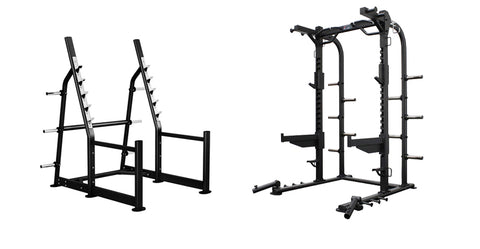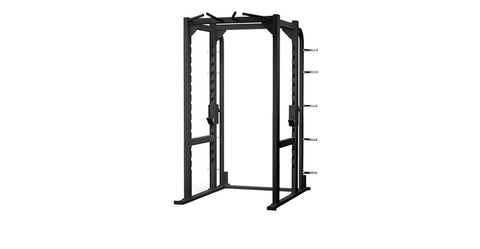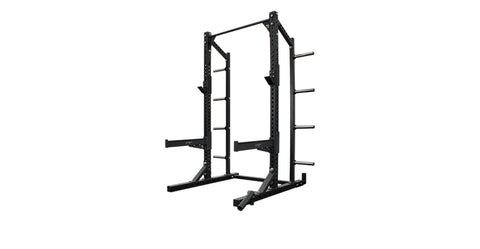SQUAT RACKS & POWER RACKS
What’s the difference between a Power Rack, Squat Rack & Power Cage?
They are different names for the same or similar piece of gym equipment. It just depends on the brand, supplier or website that is listing them. They all have a similar design but quality does vary dramatically between different brands and models. This style or rack or cage has been designed so that the user can be positioned inside the 4 upright posts that are used to support the frame, barbells and attachments. Most power racks will allow you to do both bench press and squat training as you can adjust the height of the barbell position either by moving the bar catchers also known as J hooks to the desired height or they will have gun racks bolted to the uprights. They also make it easy to add a bench and we usually recommend you use a good quality adjustable bench so you or your members can perform all bench press exercises such as Incline Bench Press, Flat Bench Press, Decline Bench Press and Shoulder Press. Also if you use a bench that can’t handle the load which is a combination of bother the user and the weight they are lifting it could fail under them and this would be extremely dangerous, so don’t compromise on this to save a few dollars.
If you are concerned about space, the width required for either a power rack or half rack is the same as this depends on the width of the barbell being used and for any power racks or half racks you will usually need to use a 7ft barbell as narrower bars won’t fit due to the width of the racks. The depth may be slightly less on a half rack but again the base of the half rack is usually about the same as a power racks.
What is the difference in quality?
Quality does vary a lot the thickness of steel used on power racks will vary anywhere from 1.5 mm (17 gauge) to 4 mm (8 gauge). Domestic grade racks use 1.5 mm to 2 mm thick. Steel. Higher grade commercial power racks don’t use adjustable J hooks or bar catchers to hold barbells, they use gun racks. They referred to as gun racks as they are similar in design to racks that are used to display or store guns. That’s all. Again quality of these also varies and they should be at least 4mm thick. If they are too thin the will bend or fail under heavy loads which could be disastrous. The thickness of the steel used in manufacturing commercial power racks must be 3-4 mm thick. If the frame is to thin it will be dangerous to use at heavy. Also when comparing gauge thickness of the steel, the lower the number the thicker the steel. The thickness of the steel reduces by 10% as the number increases so don’t be fooled by models with higher gauge numbers. A really heavy duty rack will weigh over 100kg. The other thing to look at is whether the frame is mainly welded together or bolted together, as cheaper models will be mainly held together with bolts rather than welding of joints as it’s cheaper to manufacture them this way but it does compromise on the strength and safety of the power rack.
Delivery and installation?
As we are an Australian-owned and operated commercial fitness equipment supplier we also provide delivery and installation all over Australia, including Melbourne, Sydney, Adelaide, Brisbane or Perth, Gold Coast, Hobart or any regional towns and cities. You can also come and view our range in our Commercial Fitness Equipment Showroom in Melbourne.




